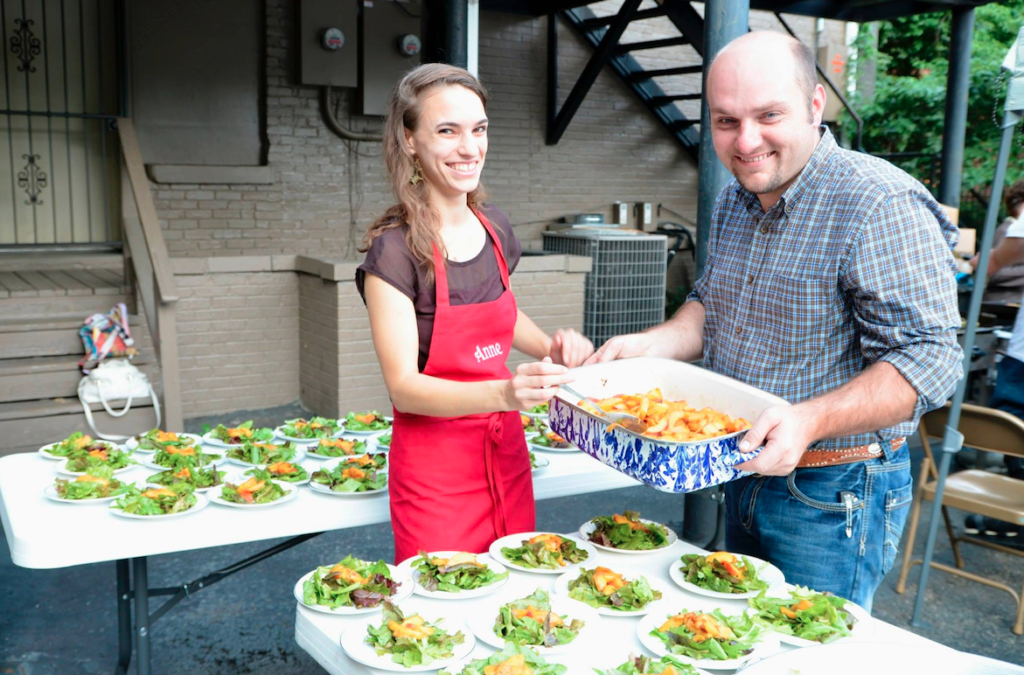

Photo provided by Mae Humiston
September’s third guest blog comes to us from Mae Humiston, Development and Communications Associate for Community Farm Alliance.
First off: Who are you? And what’s your role at your organization?
My name is Mae Humiston. I was born and raised in the mountains of Virginia and crossed the border into Kentucky in 2014 to work with Community Farm Alliance. I am currently the Development and Communications Associate, which means I do everything from grant writing to newsletter updates, as well as some on-the-ground work with the Perry County Farmers Market and “Breaking Beans: The Appalachian Food Story Project.”
How does your organization advocate for/work for/connect with local foods work in the region?
For over 30 years, Community Farm Alliance members have worked to support Kentucky’s family farmers. Local foods work is obviously a natural connector to, and supporter of, Kentucky’s family farms, especially since so much of the local foods “movement” is about getting to know your farmer. Food and agriculture, while maybe not the most lucrative sector, is a very powerful tool to highlight, negotiate, and address many of the issues facing the region, from economic opportunity to rates of diet-related diseases to land use and ownership.
While we are a statewide organization, we have staff based out of three Eastern Kentucky counties because CFA has several initiatives in the region, all connected and aligned to support Appalachia’s farmers.
Our Farmers Market Support Program is a great example of the power of food to be an issue “nexus” – farmers markets provide low-risk market entry for farmers and connect people to fresh, healthy food. The Farmers Market Support Program provides support to farmers markets across the state via technical assistance, a market manager cost-share, and a Double Dollars cost-share. Double Dollars is a program to double the value of people’s SNAP, WIC, and Senior Vouchers dollars, so that people of all income levels are able to access the healthy produce available at the market. This program leverages federal nutrition assistance funds and state and private investment, and incentivizes spending those funds with your local farmer!
CFA has also been piloting several innovative programs at the Whitesburg/Letcher County Farmers Market that can be duplicated at other markets, including a vegetable prescription program (“FARMacy”), farmers markets as USDA Summer Feeding Sites, Kid’s Bucks, a walking program, and more.
To share these program models and foster communication across our partners in food and agriculture work in Appalachia, CFA is rebooting our Eastern Kentucky Food System Collaborative. The Collaborative will provide dedicated communications for Eastern Kentucky’s food and ag stakeholders, which will allow for increased collaboration and coordination on projects, funding opportunities, and policy issues.
CFA also employs an Eastern Kentucky Farm to Table Coordinator to foster connections between institutional buyers and farmers ready to scale up from farmers market retail. But that’s not to discount the importance of small farmers and community farmers markets! Indeed, local community initiatives are perhaps the most important part of building a strong local food sector. In recognition of this, CFA provides some capacity to local foods groups in the region to support those initiatives. Lifting up the efforts and voices of people on the ground is really what this work is about.
Which brings me to my pet project, “Breaking Beans: The Appalachian Food Story Project.” Breaking Beans lifts up the stories of people working in food and farming in our region. It’s about highlighting the work that’s going on and the related successes and challenges, and about building our local food network and narrative. You can check out some of our Breaking Beans pieces on our CFA blog or catch our radio show on WMMT the first Wednesday of every month at 6pm.
Can you share a compelling example of the local foods movement in Appalachia from your perspective?
I think the most compelling example of what local foods can do for our region is that of Shane Lucas, a former coal miner who has decided to try farming as a way to stay in the region. But rather than me tell the story, I invite you to check out Angie Hatton Mullins’ Breaking Beans piece on Shane.
What role does local food play in your vision of Appalachia’s Just Transition movement?
Agriculture and local food will not, and should not, be the single solution for Appalachia’s Just Transition. But, we do see promise in the local food sector for the Appalachian region. This area has a rich history of production, local foods are in high demand, and food is a space of intersection for so many issues. Local foods bring issues of economic opportunity, health, and land use into the same room. One person’s income is another person’s medicine.
Food connects us back to our bodies, our land, and our heritage. It raises questions and solutions as to what we do with our natural resources, how we responsibly manage what we’ve been blessed with, and how we preserve, adapt, and share our blessings with the world.
On a very basic level, good food seems to do a lot to foster the kind of conversations we as a region need to be having. As miner/farmer Shane Lucas says, “We don’t have to be against each other.”
CFA’s work is driven and made possible by members. You can become a member and learn more about their work at http://cfaky.org/ .
If you have questions about CFA’s work in Eastern Kentucky, you can contact one of their eastern Kentucky staff:
Jann Knappage, Farm to Table Coordinator ()
Valerie Horn, AppalTREE Director and Eastern Kentucky Food System Collaborative Coordinator ()
Maggie Smith, Northfork Local Food Coordinator ()
Or Mae Humiston, Development and Communications Associate ()